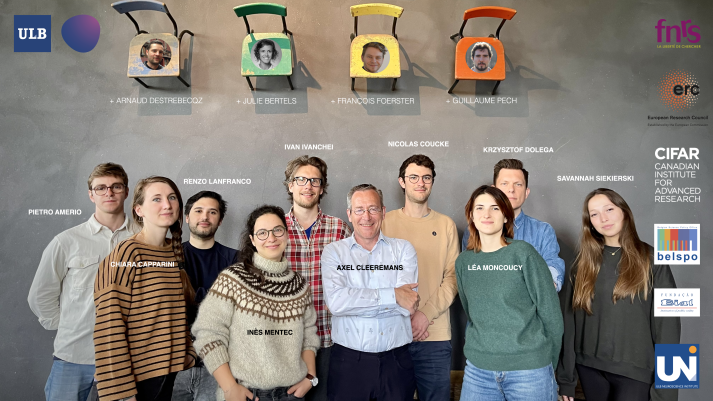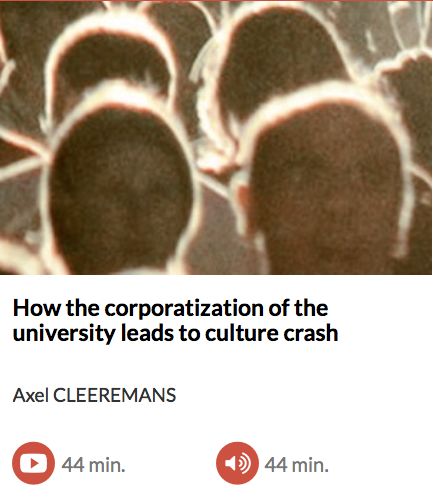Hi There!




Here is my lab @ ULB — the Consciousness, Cognition & Computation Group.

The group’s research has always been essentially focused on elucidating the mechanisms that subtend implicit and statistical learning, but its research interests have now broadened substantially to explore the differences between conscious and unconscious processing in domains such as voluntary action and the sense of agency, decision making (including pathological gambling), visual awareness and priming, conditioning and associative learning, skill acquisition, as well as hypnosis, placebo, and suggestion. Additional research lines focus on virtual reality, emotion, cognitive development, cognitive control, and eating behaviour. Some of these research lines take place through the COOL network, which we coordinate.

A second focus is on developing and testing a novel, dynamical theory of consciousness in which learning plays a central role. From this perspective ("The Radical Plasticity" project, funded by the European Research Council), consciousness arises as a result of the brain’s continuous attempts at predicting not only the consequences of action on the world and on other agents, but also the consequences of activity in one cerebral region on activity in other regions. By this account, the brain continuously and unconsciously learns to redescribe its own activity to itself, so developing systems of metarepresentations that characterize and qualify their target representations. To get an overall feel for my perspective on the problem of consciousness, read Consciousness: The Radical Plasticity Thesis and Learning to be conscious and consult this page.
In parallel with exploring the "HOW" of consciousness, a second ERC grant (EXPERIENCE) now leads us to look into the "WHY" of consciousness: What is the function of phenomenal experience? You can follow what we do by following the project's twitter account.
To explore these issues, the team combines the three main methods characteristic of contemporary cognitive neurosciences, namely behavioural, brain imaging, and computational modelling methods. CO3 has developed specific expertise in elaborating detailed neural network models of performance in various domains of cognition, and of designing and testing methods to explore the relationships between conscious and unconscious processing. The group has also recently acquired and installed a baby lab to initiate cognitive research on infants.
The lab's research is funded by different sources, including the ULB Neuroscience Institute, the F.R.S.-FNRS, BELSPO, Innoviris, the Walloon Region, the BIAL Foundation, the Canadian Institute for Advanced Research and the European Research Council. The lab is part of the Fondation ULB's research portfolio. Check out our research on the CRCN website.
This is the 2014-2019, "RADICAL" lab:


View full list of downloadable publications

Lanfranco, R.C., Canales-Johnson, A., Rabagliati, H., Cleeremans, A., & Carmel, D. (2024). Minimal exposure durations reveal visual processing priorities for different stimulus attributes. Nature Communications, 15:8524.
Cleeremans, A., & Tallon-Baudry, C. (2022). Consciousness matters: Phenomenal experience has functional value. Neuroscience of consciousness, 1: niac007
Cleeremans, A., Achoui, D., Beauny, A., Keuninck, L., Martin, J.-R., Muñoz-Moldes, S., Vuillaume, L., & de Heering, A. (2020). Learning to be conscious. Trends in Cognitive Sciences. Preprint
Cleeremans, A. (2014). Connecting conscious and unconscious cognition. Cognitive science, 38(6), 1286-1315. PDF
Timmermans, B., Schilbach, L., Pasquali, A., & Cleeremans, A. (2012). Higher-order thoughts in action: Consciousness as an unconscious redescription process. Philosophical Transactions of the Royal Society B: Biological Sciences, 367(1594), 1412-1423. PDF
Cleeremans, A. (2011). The Radical Plasticity Thesis: How the brain learns to be conscious.
Frontiers in Psychology, 2, 1-12. PDF
Cleeremans, A. & Jiménez, L. (2002). Implicit learning and consciousness: A graded, dynamic perspective. In French, R.M. & Cleeremans, A. (Eds.), Implicit Learning and Consciousness: An empirical, philosophical and computational consensus in the making (pp. 1-40). Hove: Psychology Press. PDF
Cleeremans, A. (1997). Principles for implicit learning. In D.
Berry (Ed.), How implicit is implicit learning? , pp. 195-234. Oxford: OUP. PDF
Timmermans, B., & Cleeremans, A. (2015). How can we measure awareness? An overview of current methods. In M. Overgaard (Ed.), Behavioural Methods in Consciousness Research, Oxford: Oxford University Press, pp. 21-46. PDF
Vermeiren, A., & Cleeremans, A. (2012). The validity of d’ measures. PLoS One, (7)2, e31595. PDF
Sandberg, C., Timmermans, B., Overgaard, M., & Cleeremans, A. (2010). Measuring consciousness: Is one measure better than the other? Consciousness & Cognition, 19, 1069-1078. PDF
Seth, A.K., Dienes, Z., Cleeremans, A., Overgaard, M., & Pessoa, L. (2008). Measuring consciousness: Relating behavioural and neurophysiological approaches. Trends in Cognitive Sciences, 12(8), 314-321. PDF
Doyen, S., Klein, O., Pichon, C.-L., & Cleeremans, A. (2012). Behavioural priming: It’s all in the mind, but whose mind? PLoS One. PDF
Waroquier, L., Marchiori, D., Klein, O., & Cleeremans, A. (2010). Is it better to think unconsciously or to trust your first impression? A reassessment of Unconscious Thought Theory. Social Psychological and Personality Science, 1(2), 111-118. PDF
Caspar, E. Christensen, J.F., Cleeremans, A., & Haggard, P. (2016). Coercion changes the sense of agency in the human brain. Current Biology, 26, 1-8. Media coverage
Caspar, E., De Beir, A., Magalhães de Saladanha da Gama, P., Yernaux, F., Cleeremans, A., Vanderborght, B. (2014). New frontiers in the rubber hand experiment: When a robotic hand becomes one’s own. Behaviour Research Methods. PDF
Magalhães de Saladanha da Gama, P., Slama, H., Caspar, E., Gevers, W., & Cleeremans, A. (2013). Placebo-suggestion modulates conflict resolution in the Stroop Task. PLos One 8(10): e75701. PDF
Atas, A., Faivre, N., Timmermans, B., Cleeremans, A. & Kouider, S. (2013). Nonconscious learning from crowded sequences. Psychological Science, 25(1), 113–119. PDF
Windey, B., Gevers, W., & Cleeremans, A. (2013). Subjective visibility depends on level of processing. Cognition, 44(2), 404-409. PDF
Maquet, P., Laureys, S., Peigneux, P., Fuchs, S., Petiaux, C., Phillips, C., Aerts, J., Delfiore, G., Degueldre, C., Meulemans, T., Luxen, A., Franck, G., Van der Linden, M., Smith, C., & Cleeremans, A. (2000). Experience-dependent changes in cerebral activation during human REM sleep, Nature Neuroscience, 3(8), 831-836. PDF
Destrebecqz, A., & Cleeremans, A. (2001). Can sequence learning be implicit? New evidence with the Process Dissociation Procedure, Psychonomic Bulletin & Review, 8(2), pp. 343-350. PDF
Cleeremans, A., Destrebecqz, A., & Boyer, M. (1998).
Implicit learning: News from the front. Trends in Cognitive Sciences, 2, 406-416. PDF
Cleeremans, A. & McClelland, J.L. (1991). Learning the structure of event sequences. Journal of Experimental Psychology : General, 120, 235-253. PDF
Cleeremans, A., Servan-Schreiber, D., & McClelland, J.L. (1989). Finite State Automata and Simple Recurrent Networks. Neural Computation, 1, 372-381. PDF
Cleeremans, A. Hans le Malin: Les sciences cognitives à la croisée des chemins.
Goodies:
I teach the Philosophy of Cognitive Science (Philosophie des Sciences Cognitives, PHILB-315) class in the Faculté de Philosophie et Sciences Sociales, together with philosopher Jean-Noël Missa. This class is accessible to any master-level student from the Faculté de Philosophie et Sciences Sociales or from the Faculté des Sciences Psychologiques et de l'Education.

Goodies:
I have spoken in public on many different occasions and in hundreds of different places over the years, from scientific lectures delivered in stately lecture halls to interviews in television studios.
A fraction of these interventions have been recorded and are available on youtube.
My talk "Solving Consciousness" for the 2021 Frontiers Forum has attracted 1M+ views and you can view it too here!
The Royal Academy of Belgium also has a terrific "TV" website containing a substantial collection of audio and video recordings of lectures delivered within its stately walls. I have my own little channel there.


Download Mac OS X application
Download Windows application
View Source Code
Rumelhart, D.E., McClelland, J.L., and the PDP research group (1986).Parallel Distributed Processing Volume 1: Foundations, MIT Press.
Here is a list of all sorts of interesting places on the web:
Not really. My philosophy about hobbies is embodied in this Andrew Carnegie quote:
"My heart is in the work"
I still remember the moment I first saw it engraved on the ceiling of Carnegie Mellon's Baker Hall and breaking out a sweat getting all anxious about finishing the Ph.D. I hadn't started yet. My concept of a vacation is when I am alone in my office while everybody thinks I am on vacation. In light of the above, here is another quote (from Lily Tomlin) I've grown to appreciate:
"The trouble with the rat race is that even if you win it, you're still a rat"
Other than that, I like zombies, koalas, rollercoasters, ferris wheels, psychotronic videos, Octomore, and books.
If you made all it the way down here you deserve to know about my collection of photographic portraits of friends and esteemed colleagues, — my ever-expanding Cabinet of Natural Philosophers. In the spirit of the Victorian-Era fashion for "Cabinets of Natural Curiosities" — elaborate private collections of wonders from the world —, this flickr set contains pictures of famous and not-so famous scientists and philosophers. Many are friends; most work on consciousness. Enjoy!
